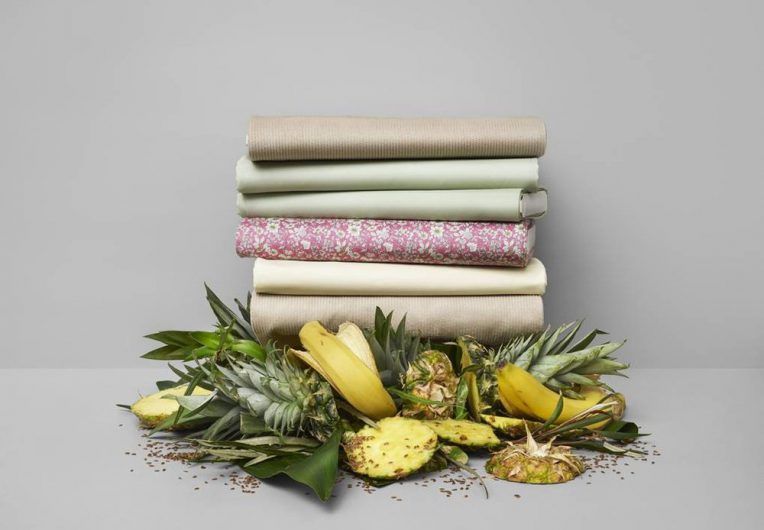Consumers, food businesses, and policymakers are increasingly aware of the need to improve our food system’s impact on the environment. But what about the impact of the clothes we wear – another major product of agriculture?
Roughly 20% of industrial water pollution comes from garment manufacturing, according to the World Resources Institute, and the industry uses 1.3 trillion gallons of water each year to dye fabric alone. This is enough to fill 2 million Olympic-size swimming pools.
For one startup tackling the textile industry, the carbon footprint of your closet is just as important as the carbon footprint of your grocery list.
“[Ours] is a new and novel biorefinery process. All the energy and biochemistry required to run the mill has a beneficial impact, and all of it is generated from the plant waste,” Circular Systems CEO Isaac Nichelson tells AFN.
“There’s a big hole in the processing of natural fibers in that the fiber is great, but the processing creates a bunch of effluents with nowhere to go. They either build up caustic salts in landfills that leach into the water table, or go out the back of the factory into a river.”
Los Angeles-based Circular Systems has developed what it describes as a completely closed-loop system for textile production. Taking top prize at the 2018 H&M Global Change Award, the system is the brainchild of a few seasoned professionals from various supply chain points of textile production, which each boast more than 25 years experience in their respective fields, Nichelson says.
Textile mini-mills
Dubbed the Agraloop Bio-Refinery, the patent-pending tech transforms food crop waste into high-value natural fiber products. to do this, it uses what Circular Systems claims is a cost-competitive and scalable method which provides sustainable and regenerative benefits. Agraloop’s miniature textile mills can utilize a range of feedstocks including oilseed hemp, oilseed flax, and rice straw as well as pineapple leaves, banana tree trunks, and sugar cane bark. Typically, the byproducts and residual feedstocks from these crops are burned or discarded.
“The project started through our [chief technology officer] Yitzac Goldstein’s long-term product development role in the textile industry where his primary focus from the beginning of his career was sustainability. This goes back to the early 1990s,” Nichelson explains.
“He came from a permaculture and organic farming background and went to China in 1992 to look at traditional Chinese agricultural practices.”
Goldstein applied systems thinking to China’s natural fiber world, which led to blending organic cotton with linen and hemp-based sustainable fibers. This had not been done before, according to Nichelson. Although the end product offered more sustainability than conventional counterparts, certain aspects of the processing required to create the textiles left a lot to be desired.
“The way processing was happening with these natural fibers was destruction,” Nichelson says. “Water retting [the fiber separation process] in China creates huge pollution and eutrophication. The wet processing system makes fibers spinnable, but it involves lots of energy-intensive broilers, and coal energy is used in China to fuel them. It also involves the use of sodium hydroxide.”
Part of what makes Agraloop a more sustainable option is its ability to use some of the waste it creates to generate energy. The mills can also potentially create energy that can be put back into the electrical grid and allocated to the surrounding area. Furthermore, the leftover byproduct can be applied as a natural soil amendment.
H&M, Levi’s on board
Circular Systems is hoping to scale its Agraloop technology by working with existing processing facilities and retrofitting them with the equipment needed to run the system. It’s engaging with the farming community to find producers who have byproducts that can be turned into fiber.
The company will also be the ultimate off-taker of the fiber, which it will primarily sell as yarn. So far, it has worked with a few major clothing manufacturers, including H&M. It’s gearing up for a late 2020 launch of the first Agraloop biofiber product for H&M’s Conscious range and there are plans to scale its textile into the brand’s other lines in 2021. Jeans maker Levi’s has also provided Agraloop with a $50,000 grant aimed at boosting product development.
“Brands are seeking us out. They are absolute catalysts and supporters of what we are doing, and without them, we would not be in the position we are in now of scaling and making beneficial impacts in this world,” Nichelson says.
“Covid-19 is accelerating that, as the pandemic has [had] the entire world at home thinking about the state of the world for the last six months. Demographic studies are showing that younger generations are acutely aware of sustainability-related problems and feel threatened by them.”
Calling all farmers
The end goal isn’t to create a mega-Agraloop, but to replicate the mini-mills in locations where it makes sense to do so. Each of these bio-refineries costs between $10 million and $20 million, and are designed to serve areas no bigger than roughly 100 to 150 square miles. They require about 10,000 to 30,000 acres of feedstock-producing crops. Agraloop is taking a variable approach to structuring each mill. In some situations, it may make sense for the feedstock-producing farmers to retain ownership of the soil amendment product that results from processing to improve their soils. In other contexts where the soil is already at optimum health, the soil amendment can provide another stream of revenue as a product sold to other growers.
Calling all farmers, Agraloop is eager to hear from producers who are interested in supplying their feedstocks to its mini-refineries.
“Farmers, farming co-ops, or regional consortiums interested in creating high value from what is otherwise waste in their fields should contact us,” Nichelson says.
“If you want to monetize that waste stream, build soil, capture carbon, and see what is otherwise going up in smoke turned to a product, please reach out. We need really consistent inputs on a big scale.”




